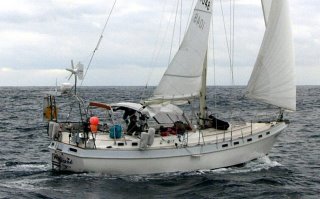At the top we found a more or less level plateau. The view from the highest peak (689') was stunning. We could see our next anchorage on the south end of Isla San Jose, with a large mangrove swamp behind a sand bar and the break in the bar caused by the water run off from the tall hills (2089') that run down the center of the island. Also clearly visible was a small island that has been continuously occupied by fisherman for well over 70 years. They have built blockhouses, some two stories, and
a church. Some other islands and the San Jose Channel were also visible. And this was only looking north!
The photos, which will be posted as soon as we reach a town, are much better than my description.
The most interesting part of the hike was that on the plateau near the top we found three areas that had lots of large seashells, much larger than a bird could carry. At each site we also found a hard flat rock with a smooth egg shaped piece of granite on it or nearby. Looking at the site it was obvious to us that native peoples used these to pound shellfish to make them palatable. The high position would allow them to spot enemies coming from any direction.
The early Spaniards described the Baja shoreline as being full of shellfish. These explorers also said shellfish was the staple for the "Indians". The Spaniards destroyed the shellfish over many decades looking for pearls. The granite rock did not come Isla San Francisco or the nearby islands to the south.
Realizing what we were looking at both Steve and I felt very fortunate to be able to see this in its natural state.
Sunday evening was a potluck dinner with about a dozen boats on the beach.
Monday we moved north about 5 miles to the south end of Isla San Jose. While beachcombing we found granite stones like we found on the top of Isla San Francisco.
Posted I hope Monday afternoon via ham radio.

No comments:
Post a Comment